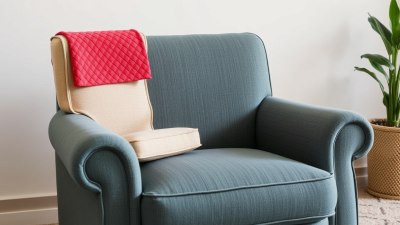How Heat Turns Your Favorite Chair Into a Mild Threat
Discover how heat affects your favorite chair, potentially turning it into a mild threat and learn how to protect your furniture and health.

Image created with Flux Schnell
Many of us have that one favorite chair in our homes - the one we gravitate towards for relaxation, reading, or watching TV. Over time, however, this cherished piece of furniture can silently transform from a source of comfort into a mild threat, especially under the influence of heat. Whether from sunlight, room temperature changes, or proximity to heating sources, heat can affect chairs in numerous ways that impact both their integrity and your health.
Heat and the Evolution of Furniture Materials
Furniture materials have evolved significantly over the decades, with manufacturers opting for combinations of natural and synthetic materials to balance cost, durability, and aesthetics. However, these composite materials often react differently when exposed to heat. Wooden frames, for instance, can expand or contract, causing joints to weaken. Upholstery fabrics may fade or deteriorate, and foam cushions can break down, releasing volatile organic compounds (VOCs).
The increase in indoor temperatures, driven by climate change or heating appliances, means that many homes face a higher risk of furniture damage related to heat. This risk is not immediately visible but accumulates over time, leading to structural weaknesses that may result in discomfort or even injury.
The Science Behind Heat-Induced Furniture Deterioration
To understand how heat can transform a chair into a mild threat, it’s crucial to delve into the scientific processes involved. Most chairs, especially those with foam padding, contain polymers. When exposed to sustained heat, these polymers can undergo thermal degradation, a chemical process where the molecular chains break down, leaving the material brittle or sticky.
Additionally, heat can speed up the release of harmful compounds used in the manufacturing of synthetic cushions and fabrics, such as flame retardants and plasticizers. When these chemicals off-gas into the room, they can irritate respiratory systems or contribute to indoor air pollution.
Health Implications of Heat-Damaged Chairs
When a chair is compromised by heat, the effects go beyond just physical wear and tear. The release of VOCs and dust from deteriorating materials can exacerbate allergies or asthma. Prolonged sitting on compromised seating might lead to poor posture due to changes in cushioning firmness, further increasing musculoskeletal pain.
In extreme cases, the combination of heat and certain upholstery materials could pose a fire hazard, especially if fabric or padding becomes overly dry or brittle. Therefore, recognizing the warning signs and adjusting environmental conditions can be vital to maintaining both safety and comfort.
Signs Your Favorite Chair is Affected by Heat
Detecting heat damage early can prevent these mild threats from escalating. Key indicators include:
- Fabric fading or discoloration: Continuous exposure to sunlight or heat sources can change the color and texture of upholstery fabrics.
- Foam degradation: Cushions that feel hard, sticky, or crumbly rather than soft and resilient.
- Structural instability: Wobbly joints or creaking sounds that were not present before.
- Unpleasant odors: Chemical or musty smells may signal off-gassing or mold growth induced by heat and moisture.
Being vigilant about these signs can allow timely intervention and prolong the lifespan of your chair.
How Sunlight Speeds Up Furniture Aging
One of the most common heat sources impacting indoor furniture is sunlight. The ultraviolet (UV) portion of sunlight not only heats but also chemically alters materials. UV radiation breaks down chemical bonds in dyes and fibers, dramatically accelerating the fading process.
This photodegradation affects both natural and synthetic fabrics. For wooden chairs, prolonged exposure can cause drying and cracking of the surface layer. Heat combined with light thus acts synergistically to weaken furniture more quickly than heat alone.
Role of Room Temperature and Heating Appliances
Besides direct sunlight, elevated room temperatures and heating appliances also contribute to the problem. Radiators, space heaters, and even electronic devices can raise local temperatures sufficiently to impact nearby furniture.
For example, heat from a room heater placed too close to a fabric chair can cause the polyester fibers in upholstery to melt or deform subtly over months. Similarly, wooden components might warp or lose previously tight joints due to uneven expansion. Knowing how to position heating sources away from seating is essential preventive care.
The Impact of Heat on Chair Fillings and Padding
Foam padding is one of the most vulnerable parts of a chair when exposed to heat. Most padding materials consist of polyurethane foam, memory foam, or similar polymers. These can lose resilience, leading to discomfort and uneven support.
Heat accelerates the breakdown of foam's cellular structure, causing it to become less elastic. This degradation not only diminishes comfort but raises potential ergonomic concerns, as poor support contributes to back and joint pain over time.
How to Protect Your Chair from Heat Damage
Preserving your favorite chair requires a few simple but effective strategies to mitigate heat-related damage. Consider the following:
- Position furniture wisely: Avoid placing chairs in direct sunlight or too close to heat sources.
- Use window treatments: Blinds, curtains, and UV-protective films can reduce sunlight exposure.
- Maintain consistent indoor temperatures: Avoid excessive heating to minimize thermal stress on materials.
- Regular cleaning: Dust and clean to remove particles that trap heat or contribute to chemical buildup.
- Use protective covers: Slipcovers can shield upholstery from UV and heat effects.
Choosing Heat-Resistant Materials for Furniture
If you’re selecting new furniture, consider materials that withstand heat better. Natural fibers like wool and leather often have greater thermal stability compared to synthetic fabrics. Hardwood frames are generally more resistant than particleboard.
Additionally, some manufacturers now offer heat-resistant coatings or treated fabrics designed to prevent fading and degradation. Investing in these products can provide longevity and maintain appearance under challenging conditions.
When to Repair or Replace Your Favorite Chair
Despite best efforts, heat damage may accumulate to a point where repair or replacement is necessary. If squeaking joints, degraded cushions, or persistent odors affect comfort or safety, it’s time to act.
Repair options might include reupholstering, replacing foam padding, or tightening frame joints. However, extensive chemical degradation or structural compromise often warrants replacing the chair altogether for both comfort and health reasons.
Environmental Considerations and Disposal
Discarding heat-damaged furniture responsibly is crucial. Many materials can be recycled or donated if salvageable. Proper disposal helps reduce landfill waste and environmental impact from chemical off-gassing.
When purchasing new furniture, aim for sustainable brands that prioritize eco-friendly materials and production processes. This approach not only benefits you but also the planet.
Maintaining a Safer Home Environment
Understanding how heat interacts with your favorite chair offers insight into maintaining a healthier and safer home. Taking preventive measures to shield furniture from excessive heat preserves indoor air quality, reduces chemical exposure, and promotes comfort.
In summary, while the transformation of your favorite chair into a mild threat by heat is often a slow and subtle process, awareness and proactive care make all the difference. By monitoring environmental conditions, selecting appropriate materials, and performing timely maintenance, you ensure that your chair remains a source of relaxation and safety for years to come.











